Reading...
![]()
Play button
![]()
Play button
![]()
Use LEFT and RIGHT arrow keys to navigate between flashcards;
Use UP and DOWN arrow keys to flip the card;
H to show hint;
A reads text to speech;
25 Cards in this Set
- Front
- Back
|
Gratitude
|
- Positive emotion linked to situations in which one perceives that another person has intentionally given (or attempted to give) one something of value
- Being grateful is also part of religious traditions/rituals - Keeping a gratitude diary seems to significantly increase well-being in a longitudinal design (compared to a control, Emmons & McCullough, 2003) |
|
|
Gratitude and helping
Research Example: Bartlett & DeSteno, 2006 |
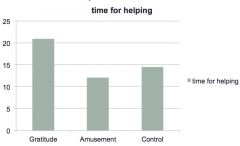
- Interaction of two individuals (confederate & actual participant) during study
Conditions: 1) Gratitude: confederate helped participant to solve a technical problem 2) Amusement: video from Saturday Night Live 3) Control - DV: willingness of the actual participant to help confederate with another study (and how long participant helped) - Interesting additional finding (Study 3) -> Making participants aware of the fact that gratitude drives their behavior eliminates the effect -> Correction process -> Dual process models!! |
|
|
Helping behavior and other affective states
|

|
|
|
Mood congruence effects
|
- State-dependency: recall is improved when individuals are in the same mood during encoding and retrieval
- Traditional view (Bower, 1987) -> Mood congruent recall of information -> Logic is derived from traditional associative network models -> Affective states supposedly function as central nodes in such networks - Mood-congruent recall of information: material with an affective tone matching the current mood are more likely to be recalled -> However, only weak support for mood congruent recall hypothesis (a number of additional factors need to be in place to obtain such findings) |
|
|
Affective influences on Emotion Perception
How do a perceiver’s emotions influence the detection of other people’s facial expression of emotion?Niedenthal et al. (2000) |
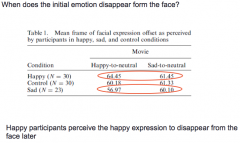
- Affect induction:
-> Happy vs. sad vs. neutral movies clips at the beginning of the study -> Happy vs. sad music during the actual experimental task (no music in control condition) - Experimental task: -> Decisions when an initial affective facial expression disappears from a face in series of morphed photographs. |
|
|
Reliable mood congruence effects
|
- Bargh & Tota (1988): Depressives have negative constructs with regard to the self and those are chronically accessible. They do not necessarily judge others more negatively, though
- Seligman (1975). Depressives have a chronic pessimistic explanatory style. Negative events are explained a) Personally – Failures are about me! (me versus external causes) b) Permanence- Failures are always about me!! (permanent versus flexible) c) Pervasiveness – I am always too stupid to do right things, I mean, really all things. (global versus specific)!!! -> Therapy: change explanatory style; give back feeling of internal control (learned helplessness) |
|
|
The affect infusion model
|
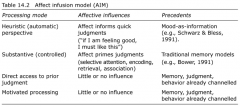
|
|
|
How does mood influence cognition?
|
- When information is processed heuristically:
Affect as information - When information is processed systematically: Selective attention/encoding/retrieval/association - No influence is expected a previous judgment is directly available, or when a motivation to pursue a goal exists |
|
|
Affective influences can be very subtle
|
- Mere exposure research shows that familiarity with an object increases liking
-> This familiarity can be artificially created -> Standard paradigm: Affective Priming task - Ease of retrieval/processing Social cognition versus Social Cognition (in fancy letters) - Perceptual fluency |
|
|
Affective Priming
|

|
|
|
Underlying idea behind “ease effect”
|
- Subjective experiences (ease, difficulty, fluency) have a strong impact on how we evaluate stimuli (metacognitive experiences)
- Difficult to read/hear/understand messages tend to be evaluated as less important/less true/less valuable - Easy to read/hear/understand messages tend to be evaluated as more important/more/more valuabe |
|
|
Mood (affect) as information
|
- Happy people might in general be more likely to rely on their mood when making judgments or evaluations
- Subtle affective cues might also be experimentally induced, or the reliance on them can be manipulated |
|
|
Mood (affect) as information
Research Example: Schwarz & Clore (1983) |
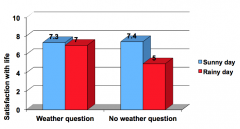
- Participants were approached by phone and asked about their mood.
Four conditions: 1) Half of Pps were approached on a rainy day. 2) Half of Pps were approached on a sunny day. A) Half of Pps were not asked about the weather. B) Half of Pps were asked about the weather. -> 2 (Day: rainy vs sunny) x 2 (Weather question: yes vs no) - Link between the weather and judgments of general life satisfaction (as an indicator of happiness) does not seem as straightforward as researchers initially thought. - Lots of methodological complexities - Lucas et al. (2013): Large 5 year study with a huge representative sample from all 50 American states (more than 1 million participants) -> No effect between weather and satisfaction with life |
|
|
Do different negative affective states have the same impact on social judgment?
|
Comparison of anger and sadness
-> Anger = associated with immediate threat, disruptive for systematic thinking -> Sadness = more prone to detailed (systematic processing) - Mood as information would suggest no difference - Emotion theorists would expect a difference between the two Bodenhausen, Sheppard, & Kramer (1994): - Manipulation of angry, sad, or neutral affect -> Vividly recalling an episode from the own life (12 min) -> Next participants read a scenario regarding a legal decision (alleged misconduct) in which a stereotypic name was either mentioned or not mentioned - Idea behind the study: -> If participants rely on the stereotypic name a key cue than they should attribute more guilt to the person. -> This would be seen as indicator of more heuristic proessing |
|
|
Trustworthiness of the source
Bodenhausen et al., 1994, Study 3 |

- Trustworthiness of the source of a message can also be seen as the basis for a quick heuristic response
- Mood induction (angry, sad, neutral) - Evaluation of an essay advocating banning meat from the university residence hall menu - Manipulation of source: 1) Student Government League (high in trustworthiness) 2) Student Vegetarian League (low in trustworthiness) |
|
|
Affect and cognition - separate systems?
|
- The key question underlying many dual systems models
- Early research suggested indeed that affective reactions are primary, basic, inescapable, irrevocable, implicating the self, difficult to vebalize etc. -> Several lines of research support this claim - However: -> Critique from appraisal researchers -> Objections based on newer findings on automatic (rapid) cognitions |
|
|
New proposel about affect and cognition by J. Russell (2003)
|

- Core affect as a neurophysiological state that is consciously accessible as a non-reflective feeling
- Mood: prolonged core affect |
|
|
Action phase model
|
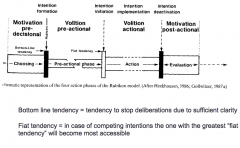
|
|
|
Cognitive aspects of goal pursuit
|
- Two distinct phases:
1)Motivational phase linked to deliberative mind-set 2)Volitional phase linked to an implementation mind-set - The distinct phases are linked to different cognitions |
|
|
Mindsets for planning behaviour
|

|
|
|
Goal-shielding
|
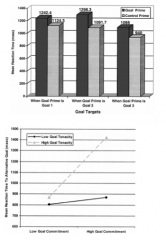
- After a goal has been selected it inhibits the accessibility of alternative goals
- Typical paradigm (e.g. Shah, Friedman, & Kruglanski, 2002): - Activation of a focal goal through priming procedure (+ control primes) - Measurement of accessibility of goal-related constructs through a modified lexical decision task: -> Goal-word (focal or competing goal) or control word -> Target word (compatible with focal goal, or with competing goals) - Idea: focal goal would inhibit the accessibility of competing goal words but not of control words - Response times for trials where prime was a different goal or a control word Competing goals are inhibited - Effect was driven by participants who showed a high goal commitment |
|
|
Goal versus implementation intentions
|
- Simply having the intention to pursue a goal is oftentimes not sufficient to show the corresponding behavior
- Implementation intentions are much better predictors of actual behavior Implementation intentions: specific if-then plans - Important distinction in all areas of psychology that focus on behavioral change (i.e. health psychology) |
|
|
Goals can be primed
|
- Goal priming follows a different pattern than other form of priming (e.g. Voodoo-doll study, Denzler et al., 2009
|
|
|
Goal activation and the Zeigarnik effect
|
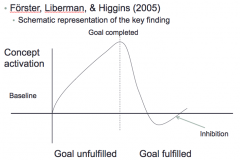
- Goal activation increases as long as the goal has not been competed
- Completion not only leads to a decrease in goal activation but also a temporal inhibition of goal related concepts - Applications of these findings -> Aggressive thoughts: Catharsis? -> Regrets about past events: a result of continued goal activation? |
|
|
Attitudes that contribute to a high attitude-behaviour consistency
|
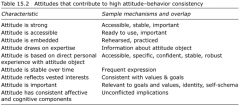
|

